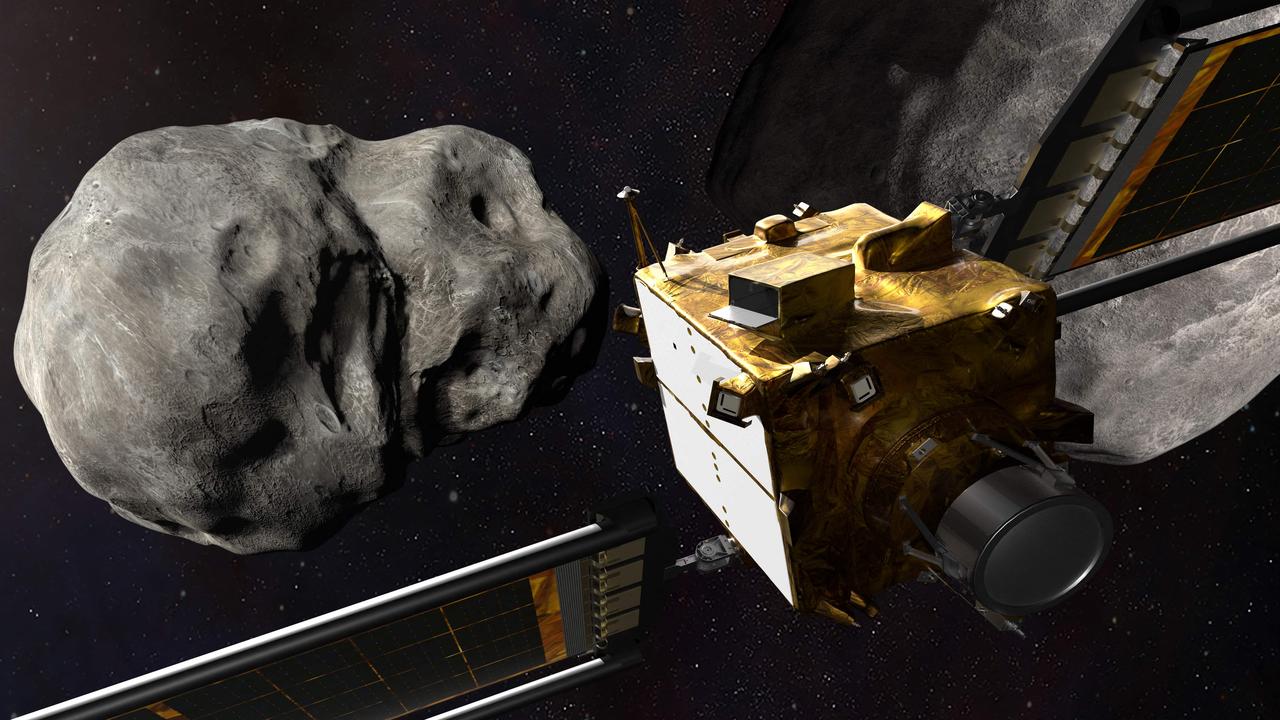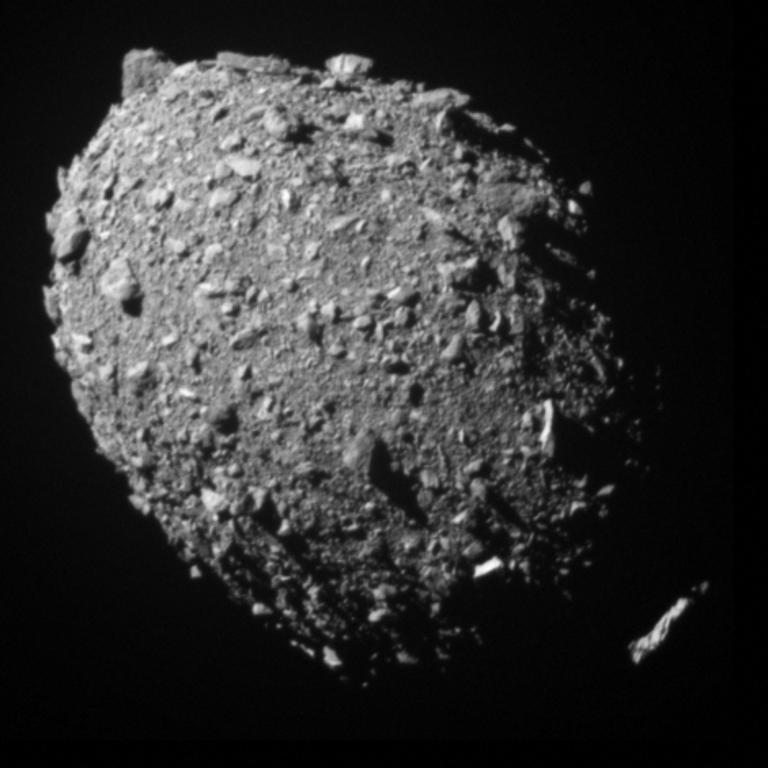Victory for humanity as NASA confirms asteroid crash alters orbit
Declared a serious ‘defender of this planet’ by NASA chief Bill Nelson, the space agency is flying high after post-impact analysis shows DART crash shortened the asteroid orbit in best-case result

READING LEVEL: ORANGE
NASA has announced it succeeded in deflecting* an asteroid* in the historic test of humanity’s ability to stop an incoming cosmic object from colliding with Earth.
The fridge-sized Double Asteroid Redirection Test (DART) craft deliberately smashed into the moonlet asteroid Dimorphos* on September 26 GMT* – but the real measure of success was pushing Dimorphos into a smaller, faster orbit around its big brother Didymos*, said NASA chief Bill Nelson.

“DART shortened the 11 hour 55 minute orbit to 11 hours and 23 minutes,” he said.
Speeding up Dimorphos’ orbital period by 32min easily exceeded NASA’s own expectation of 10min.
“We showed the world that NASA is serious as a defender of this planet,” added Mr Nelson.
The asteroid pair loop together around our sun every 2.1 years and pose no threat to our planet.
But they are ideal for studying the “kinetic* impact” method of planetary defence, in case an actual approaching object is ever detected.
DART’s success as a proof-of-concept has made science fiction come true.

Astronomers* rejoiced in stunning images of matter spreading out thousands of miles in the wake of the impact – pictures collected by Earth and space telescopes, as well as a mini satellite that had travelled to the zone with DART.
Thanks to its temporary new tail, Dimorphos, which is 160m in diameter or roughly the size of a big Egyptian pyramid, has turned into a man-made comet*.
But assessing just how well the test worked meant analysing light patterns from ground telescopes, which took a few weeks to become apparent.
The binary* asteroid system, which is around 11 million km from Earth, is visible from the ground only as a single dot.

Ahead of the test, NASA scientists said the results of the experiment would reveal whether the asteroid was a solid rock, or more like a “rubbish pile” of boulders bound by mutual gravity.
If the asteroid was more solid, the momentum* imparted by the spaceship would be limited. But if it was “fluffy”, an additional boost would occur when significant mass was pushed at high velocity* in the opposite direction to impact.
Never actually photographed before, Dimorphos appeared as a speck of light around an hour before impact.
Its egg-like shape and craggy, boulder-dotted surface finally came into clear view in the last few moments, as DART raced toward it at roughly 23,500km per hour.

Very few of the billions of asteroids and comets in our solar system are considered potentially hazardous* to our planet, and none are expected to trouble Earth in the next hundred years or so.
But the geological* record shows that a roughly 10km-wide asteroid struck Earth 66 million years ago, plunging the world into a long winter that led to the mass extinction* of the dinosaurs along with 75 per cent of all species.
An asteroid the size of Dimorphos, by contrast, would only cause a regional impact, such as destroying a city.

Kinetic impact with a spaceship is just one way to defend the planet, albeit the only method possible with current technology.
Should an approaching object be detected early, a spaceship could be sent to fly alongside it for long enough to divert its path using the ship’s gravitational pull, creating a so-called gravity tractor.
Another option would be launching nuclear explosives to redirect or destroy an asteroid.
NASA believes the best way to deploy such weapons would be at a distance, to impart force without blowing the asteroid to smithereens, which could add further risk to Earth.
GLOSSARY
- deflecting: changing direction after hitting something or causing something to do so
- asteroid: rocky objects that orbit the sun but are much smaller than planets
- Dimorphos: the name comes from the Ancient Greek word meaning “having two forms”
- Didymos: the name comes from the Ancient Greek word for twin
- kinetic: involving or producing movement
- astronomers: scientists who study stars, planets, and other natural objects in space
- comet: bright object with a long tail of gas and dust particles that travels around the sun
- binary: made of or relating to two things
- momentum: the force or speed of an object in motion
- velocity: speed at which an object is travelling
- hazardous: dangerous, risky, unsafe, threatening health and safety
- geological: related to the science of the physical nature and history of Earth
- extinction: dying out of a species, when something ceases to exist
EXTRA READING
Strange diamonds formed after outer space incident
First images of DART asteroid impact
Dino meteorite ignited destructive wildfires
QUICK QUIZ
- What did the DART impact shorten the asteroid’s orbit from and to?
- How long does it take the pair of asteroids to orbit the sun?
- How far away are the asteroids from Earth?
- DART was travelling at what speed at impact?
- How big was the asteroid that struck Earth 66 million years ago?
LISTEN TO THIS STORY
CLASSROOM ACTIVITIES
1. Create a diagram
Create a diagram that explains how the DART works and what its impact was.
Time: allow 30 minutes to complete this activity
Curriculum Links: English; Science
2. Extension
“The last time an asteroid hit Earth was 66 million years ago. NASA is wasting money and time that should be spent on more important space research!”
Do you agree with this statement? Write your reasons for or against.
Time: allow 25 minutes to complete this activity
Curriculum Links: English; Science
VCOP ACTIVITY
Wow word recycle
There are plenty of wow words (ambitious pieces of vocabulary) being used in the article. Some are in the glossary, but there might be extra ones from the article that you think are exceptional as well.
Identify all the words in the article that you think are not common words, and particularly good choices for the writer to have chosen.
Select three words you have highlighted to recycle into your own sentences.
If any of the words you identified are not in the glossary, write up your own glossary for them.

